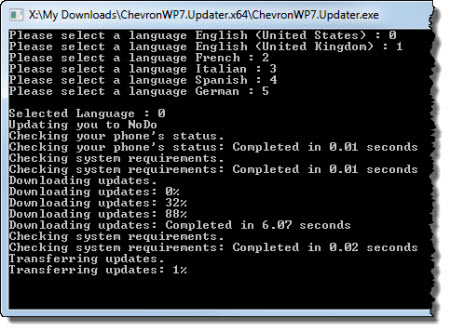Developer bypasses carriers, delivers Windows Phone update

Update: According to Chris Walsh, the Chevron Updater tool was downloaded more than 25,000 times in 12 hours of availability. The update package is not currently available for download. Via Twitter, Walsh declined to comment on the reasons why the update was pulled.
In the last two months, Microsoft has released a pair of updates to its Windows Phone software, including the March update (“NoDo”) which adds bug fixes, performance improvements, and copy-and-paste support.
Although Microsoft manages the actual delivery process, many early adopters are still waiting for their mobile carriers to finish their testing and allow those updates to be delivered. I know, because I use a Samsung Focus on AT&T’s network, and according to Microsoft’s “Where’s My Windows Phone Update?” page, AT&T isn’t due to complete its testing until “early April 2011.” (It's enough to make me want to leave AT&T completely.)
If you’re tired of waiting, developer Chris Walsh (@ChrisWalshie on Twitter) can cut you to the front of the line with an unofficial, unsupported, do-this-at-your-own-peril standalone updater. (Walsh is no run-of-the-mill developer. He worked with Long Zheng and Rafael Rivera to develop the ChevronWP7 tool to help developers unlock Windows Phone 7 devices. That app caused some consternation at Microsoft and earned the team an invitation to Redmond for some in-depth talks with Microsoft developers, who promised to work with the trio on upcoming tools.)
You can read Walsh's blog post and download the necessary files here: So who wants Windows Phone Updates, like right now?
Well, first, thanks go out for Microsoft for releasing a support tool for Windows Phone yesterday. Inside that tool, were unreal hidden gems.
Basically they’ve created a managed wrapper over the whole update process for us, rather nice of them.
So I flashed my HTC Mozart back to RTM (7004) via a ROM update HTC ship and whipped up a little application to flash pre-NoDo (7004), NoDo (7355), NoDo update 1 (7389) & NoDo update 2 (7390) all in a single process. No I don’t care which carrier you are on, which phone you have, it’ll just update your phone accordingly.
In the interests of science, I downloaded the Windows Phone Support Tools and the Chevron updater for my Windows 7 x64 system. I checked the language settings on my phone and confirmed that my language (US English) is supported. I followed Walsh’s instructions to the letter, installing the Microsoft-signed Windows Phone Support Tools package first, then running the Chevron updater.
It’s a console-based program, which means it runs in a sparse, text-based window. The only input required is for you to enter the number associated with your language.
Before I began the update, I connected the phone to my system using its USB cable and checked the Zune software to confirm that it was still stuck on the original (version 7004) software. “Your phone is up to date,” it said, adding that the current phone software version was 7.0 (7004).
And so I held my breath and launched the Chevron updater. And watched and waited, somewhat anxiously.
If you’re still running version 7004, as I was, the updater actually has to run twice—once to install the February update, and then again to install NoDo. After the February update completed, I saw this message in the console window:

And then I waited some more. Graphics on the phone itself indicated that the device was connected, and a progress bar at the top of the screen displayed the update’s progress more effectively than the dots in the console window.
The update process took a total of less than 10 minutes from start to finish. When it was complete, the console window closed, my phone returned to its lock screen, and I confirmed, in the Zune software and on the phone itself, that the device had indeed been updated to the latest version.
I did a few quick tests to confirm that every function was working as expected, and saw nothing out of the ordinary. Indeed, the phone feels faster, and apps load noticeably quicker than before. I also checked out the copy-and-paste feature and confirmed that it is indeed available. More on that later.
Do I recommend that you run an unauthorized updater on a $500 [*] device? Absolutely not. The rewards are relatively small, and the wait should be only a few weeks, even for AT&T. Still, if you’re aware of the potential problems and are willing to accept the risks, it’s comforting to know that you really can bypass the carriers.
If you’ve decided to take the plunge and update a WP7 device, leave a comment in the TalkBack section and let me know how it went for you.
Update: Several owners of Samsung Focus phones have commented that they had problems with the update. According to Walsh, the fix is to run the Windows Phone Support Tool and restore the phone to its original firmware first, then perform the update. Although I've seen this option I haven't tested it and can't personally recommend it.
[*] In the comments, several readers took issue with my warning about the potential for bricking "a $500 device." They point out that you can get a Windows Phone for $50 from AT&T or for a buck from a third-party reseller such as Amazon. That is true IF you do not currently have a contract AND you are willing to sign a two-year agreement. After you purchase that subsidized device, you have a contractual obligation. If you lose your phone, drop it in a lake, brick it with a faulty software installation, or otherwise render it unusable, you will have to pay the full, unsubsidized cost (the "no commitment" price) for a replacement device. Currently at AT&T, that is $450 + tax and shipping for an HTC Surround, for a total price of around $500. The Samsung Focus goes for $350 unsubsidized.
See related coverage: